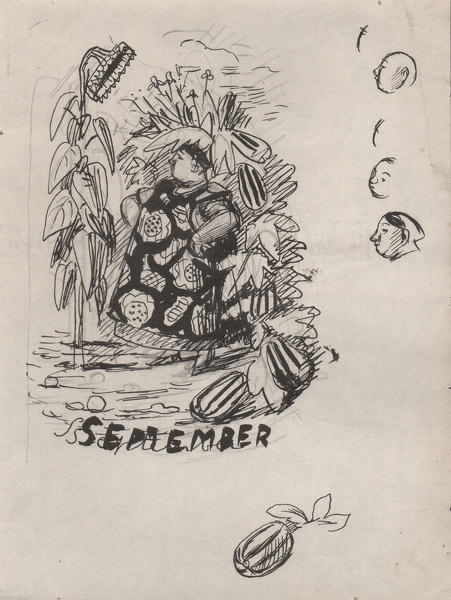 £475
£475
Evelyn Dunbar:
September, preparatory drawing for Country Life 1938 Gardener’s Diary [HMO 232]
Framed (ref: 6713)
Pencil and pen & ink on paper
Condition: Surface dirt
8½ x 6¼ in. (21.5 x 16 cm)
Tags: Evelyn Dunbar ink pencil allegory flowers women Dunbar catalogue Evelyn Dunbar - The Last Works Evelyn Dunbar at The Watts Gallery
Provenance: Roger Folley; Alasdair Dunbar; Hammer Mill Oast Collection
Exhibited: Evelyn Dunbar - The Lost Works, Pallant House Gallery, October 2015 - February 2016, cat 66. Literature: Evelyn Dunbar - The Lost Works, eds Sacha Llewellyn & Paul Liss, July 2015, cat. 66, page 107: Evelyn Dunbar: A Life in Painting, Christopher Campbell-Howes, October 2016, page 232. Noel Carrington, at one time Dunbar’s Hampstead landlord, was keen to promote the work of those artists he admired. In 1937 as editor at Country Life Ltd. – a satellite publishing entity of the eponymous magazine – he commissioned Dunbar to create the 1938 Gardener’s Diary. Rich in vignettes and horticultural quotations ranging from the Book of Job to Thomas Hardy, the core artwork in Dunbar’s images of the months, each of which takes human form: female in the gentler months – February (idem CAT 65; Evelyn Dunbar: A Life in Painting pages 224/5) with crocus flowers and daffodil shoots in her hat, and April (Lost Works CAT 69; A Life in Painting pages 226/7) jauntily wearing a bird’s-nest hat and carrying attributes of topiary and a garden frame. Occasionally these months are autobiographical: April is the month in which Evelyn’s baby by Mahoney would have been born had she not miscarried. July is definitely a male month with its abundance of cabbages and onions, as is November, the season for bonfires and general clearance. Dunbar was not one to waste a good idea or design, and some of these personifications recur as the principal motifs in An English Calendar (Lost Works CAT 71; A Life in Painting pages 229-231), the 6 foot square decoration she painted in 1938. Dunbar delighted in personifying abstract conceptions, returning to this device in Seven Days (Lost Works CAT 72; A Life in Painting page 239) and in her projected Faith, Hope and Charity (Lost Works CAT 109). Peyton Skipwith and Christopher Campbell-Howes
We are grateful to Christopher Campbell-Howes for assistance.















